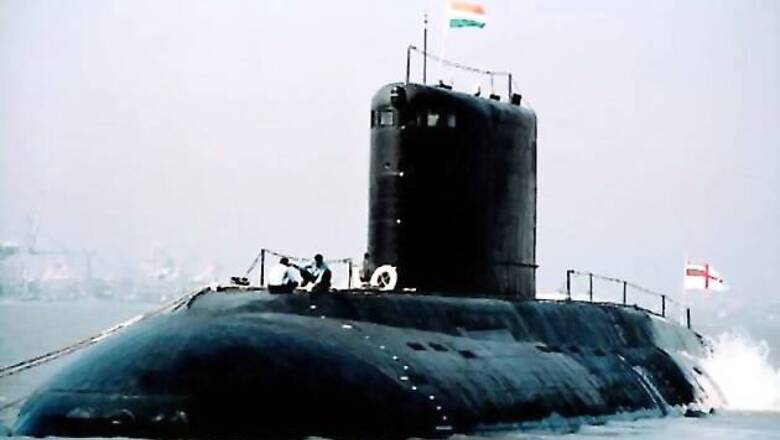
views
New Delhi: The Indian Navy is set to "very soon"issue a RfP (Request for Proposal or tender) for a new line of six submarines with AIP (Air Independent Propulsion) capability.
The requirement has been pending for quite a few years but the proposal for the new line, designated Project 75-I, has now being given firm clearance by the government, according to Indian Navy chief, Admiral DK Joshi.
Asked how soon is "very soon," the naval chief told India Strategic defence magazine (www.indiastrategic.in) that the Defence Acquisition Committee (DAC) had already cleared a note on Acceptance of Necessity (AON), the navy had finalized the RfP and it was in its last stage of formalities for clearance in the defence ministry.
As per procedures, depending on the money involved, AON has to be cleared by a competent authority. If the requirement involves more than Rs.1,000 crores ($200 million ), then it is by the DAC, headed by the defence minister. The approval was accorded just before the Navy Day on December 4, 2012.
AIP increases the mission life of a submarine by around three times, depending upon the task and parameters required. The capability enables a submarine to generate air onboard without the need to surface for breathing to recharge its batteries.
At present, none of the Indian submarines have this capability, and some of them can only be under water for only three to five days. The existing fleet of 14 diesel-electric submarines is rather weak despite the periodic upgrades, although some newer EW (Electronic Warfare) systems have been installed.
Submarines are about staying underwater as long as possible, and that is why nuclear power is used to keep them submerged for around three months, or to the limits of human endurance.
The new Project 75-I submarines should be huge in value, estimated at around $10 billion-plus, depending upon the offsets and transfer of technology (ToT).
At present, six new Scorpenes under Project 75 are being built for more than $5 billion (Rs 23,562 crore) by the state-run Mazagon Dock Ltd. (MDL) under licence from the French DCNS company.
MDL is also hoping to get the new Project 75-I line but it has substantial work in hand for years - 14 ships in addition to the six Scorpenes. The experience gained in building the Scorpenes though should be extremely useful and must not get wasted.
AIP is also being considered for the last two of the existing line of Scorpenes by installing plugs - about eight meters in length and the same diameter as that of the submarine. Admiral Joshi said that the (Defence Research and Development Organisation) DRDO was working on building these plugs, but that if this entailed delay, "we will not wait".
The Scorpene project is already late by three years, with the first submarine scheduled to be out in June 2015 - instead of 2012 - and the last in September 2018.
DCNS has offered to build the plugs and some negotiations have taken place with it. Nonetheless, DRDO's Naval Materials Research Laboratory (NMRL) at Ambernath in Maharashtra is working on the project to bring in some indigenous capability and content.
About the Project 75-I, defence ministry sources said that its Department of Defence Production was working on fine-tuning some features like Who-Will-Do-What among the Indian shipyards and the suppliers in terms of sub-systems and weapons. Details on offsets and ToT, which have a sizeable bearing on the costs, are also being given the last touches.
Notably, the defence offsets policy mandates a minimum investment of 30 percent to be put back in a related defence industrial venture in India, but in the biggest defence contract that is now being negotiated for the French Rafale Multi Role Combat Aircraft (MRCA), this figure is 50 percent.
As per indications, the RfP for the submarines should be out even in January 2013, or latest by March before the financial year 2012-13 ends.
The Indian Navy's current fleet of conventional diesel-electric submarines is quite old.
There are four HDW Shishumar class submarines acquired from Germany and 10 Kilo Sindhughosh class from Russia, both from 1986 onwards. The service life of a submarine is estimated at around 20 years, but because of political indecision after the allegations over the purchase of Bofors guns from Sweden, the modernization process of the Navy - along with that of the Army and Indian Air Force - suffered.
In 1998, the then naval chief, Admiral Vishnu Bhagwat, projected a requirement of a 24-submarine fleet in the navy's long-term vision for 30 years. In 1999, the Cabinet Committee on Security (CCS) - the apex body headed by the prime minister - approved the plan for their indigenous construction in two lines.
The Scorpenes are being built in India to gain experience and indigenous support capability. India had gained some earlier with the induction of HDW boats but as there was no follow-on programme, that experience was lost and all those involved in the project have retired.
The only direct submarine acquisition of the Indian Navy after the HDW and Kilo submarines is that of the single nuclear power attack submarine (SSN) INS Chakra from Russia in 2012. There are also some technical issues with it, and during his recent to New Delhi, Russian President Vladimir Putin promised to have them sorted out ASAP.
An SSN is a nuclear propelled but not nuclear armed submarine. The conventionally-powered diesel electric submarines are knows as the SSK class.

















Comments
0 comment